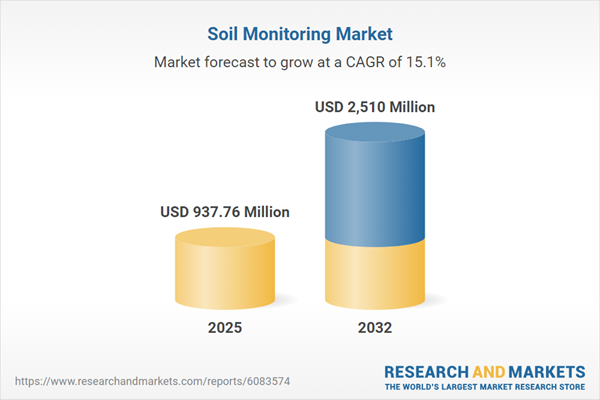Speak directly to the analyst to clarify any post sales queries you may have.
The soil monitoring market is rapidly transforming global agriculture by equipping enterprises and policymakers with the precision data required to navigate increasing resource constraints and climate variability. Stakeholders can now leverage integrated technology platforms to optimize resource allocation, mitigate risks, and support sustainable farming decisions.
Market Snapshot: Soil Monitoring Market Size and Growth
In 2024, the soil monitoring market reached USD 816.71 million and is set to grow to USD 937.76 million by 2025. This trajectory reflects a robust compound annual growth rate (CAGR) of 15.07%, on pace to achieve USD 2.51 billion by 2032. The primary keyword soil monitoring market drives sustained demand, propelled by the convergence of advanced sensor hardware, connected platforms, and regulatory measures prioritizing efficient land and water management.
Scope & Segmentation: Comprehensive Coverage Across Technologies and End Users
- Product Types: Sensors, Services, and Software form the solutions portfolio, offering everything from core data collection devices to analytics and visualization platforms.
- Sensor Technologies: Capacitive, Dielectric, Optical, and Tensiometric sensors address specific monitoring needs, from rapid in-field insights to lab-grade analyses.
- Connectivity Options: Wired (Ethernet, USB) and Wireless (Cellular, LoRaWAN, NB-IoT) solutions enable stable or flexible deployments for diverse agricultural geographies.
- End Users: Commercial agribusinesses, individual farmers, government agencies, and research institutes, each prioritizing scalability, affordability, regulatory compliance, or precision measurement.
- Regions Covered:
- Americas: United States, Canada, Mexico, Brazil, Argentina, Chile, Colombia, Peru
- Europe, Middle East, and Africa: United Kingdom, Germany, France, Russia, Italy, Spain, Netherlands, Sweden, Poland, Switzerland, United Arab Emirates, Saudi Arabia, Qatar, Turkey, Israel, South Africa, Nigeria, Egypt, Kenya
- Asia-Pacific: China, India, Japan, Australia, South Korea, Indonesia, Thailand, Malaysia, Singapore, Taiwan
- Industry Leaders: Yara International ASA, The Toro Company, Delta-T Devices Ltd, Sentek Pty Ltd, Campbell Scientific, Inc., Spectrum Technologies, Inc., Stevens Water Monitoring Systems, Inc., Irrometer Company, Inc., Arable Labs, Inc., CropX Technologies Ltd.
Key Takeaways: Strategic Insights for Decision Makers
- Advanced sensor platforms deliver actionable insights, enhancing irrigation scheduling, fertilizer application precision, and crop rotation strategies for improved operational outcomes.
- Real-time predictive analytics and IoT connectivity are enabling a shift from reactive to anticipatory farm management, supporting more resilient and sustainable agriculture practices.
- Regional differences in adoption are influenced by local infrastructure, regulatory frameworks, and funding mechanisms, requiring adaptive go-to-market approaches to maximize engagement.
- Service models now include sensor-as-a-service and pay-per-outcome contracts, expanding access and lowering entry barriers for all farm sizes.
- Integration with automated irrigation and farm management systems is strengthening the connection between soil data and end-user applications, leading to more efficient use of natural resources.
- Partnerships between technology providers and agronomy experts are catalyzing product development and rapid innovation cycles within the sector.
Tariff Impact: Strategic Response to United States Tariff Measures
New United States tariffs on electronic components introduced in 2025 have increased costs for sensor manufacturers, affecting procurement and supply chain operations. This has led to shifts in assembly activities toward tariff-free regions and a reassessment of network architectures, with greater emphasis on modular designs and alternatives like LoRaWAN and NB-IoT. Both suppliers and end users are adapting through enhanced inventory planning, pre-ordering strategies, and diversification of sourcing to ensure resilience.
Methodology & Data Sources
This report is built on a rigorous multi-method approach, combining in-depth executive interviews, a survey of over 150 diverse end users, and extensive secondary research from technical journals, white papers, and regulatory documentation. Data triangulation and validation protocols ensure accuracy and reliable strategic insights.
Why This Report Matters
- Enables senior decision-makers to benchmark technology adoption agility and supplier strategies across global markets.
- Provides actionable insights to chart growth and innovation pathways aligned with emerging technology trends and regulatory priorities.
- Helps organizations plan effective go-to-market and partnership strategies tailored to varied regional market dynamics.
Conclusion
The evolution of soil monitoring technologies is reshaping agricultural value chains, empowering stakeholders to optimize operations and meet environmental goals. Engaging with these insights ensures readiness for ongoing shifts in global resource management and regulatory expectations.
Table of Contents
3. Executive Summary
4. Market Overview
7. Cumulative Impact of Artificial Intelligence 2025
List of Figures
Samples

LOADING...
Companies Mentioned
The key companies profiled in this Soil Monitoring market report include:- Yara International ASA
- The Toro Company
- Delta-T Devices Ltd
- Sentek Pty Ltd
- Campbell Scientific, Inc.
- Spectrum Technologies, Inc.
- Stevens Water Monitoring Systems, Inc.
- Irrometer Company, Inc.
- Arable Labs, Inc.
- CropX Technologies Ltd.
Table Information
| Report Attribute | Details |
|---|---|
| No. of Pages | 181 |
| Published | October 2025 |
| Forecast Period | 2025 - 2032 |
| Estimated Market Value ( USD | $ 937.76 Million |
| Forecasted Market Value ( USD | $ 2510 Million |
| Compound Annual Growth Rate | 15.0% |
| Regions Covered | Global |
| No. of Companies Mentioned | 11 |









